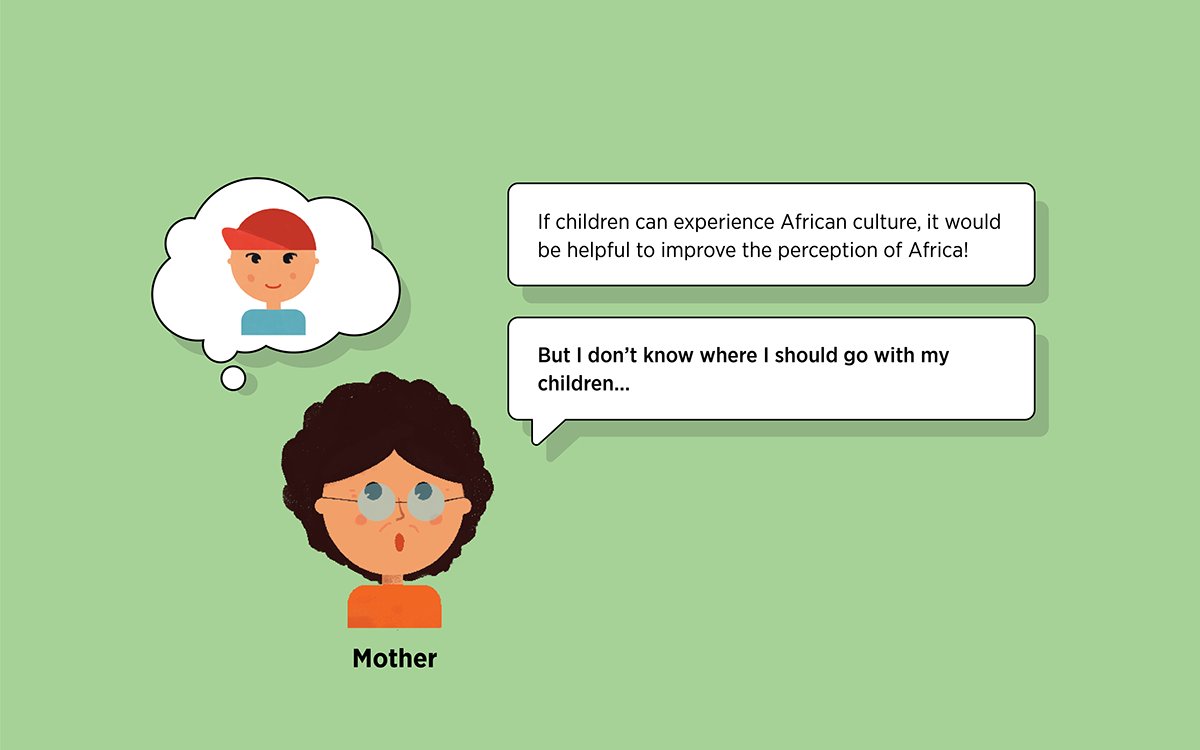Feeelgraphy | 10 months, 2015 | Team of 6
*Griot is a West African historian, storyteller, praise singer, poet and/or musician

My role: user research, concept development, project management, visualization
Brief
It began as a simple drawing workshop but... As the number of people who wanted to create some values through drawing increased, we decided to focus on doing something more meaningful. At that time, one of our members was working at TVTC school in Tanzania as a volunteer. She told us stories about what Africa is like in reality. This helped to remove the stereotypes we had of Africa. We were able to look at the vibrant diversity in Africa. So we have been working on Africa to improve the perception of the negative side of Africa since Jan. 2015.
Opportunity
The challenge is to change the negative perception about Africa that individuals have. There are rare exchanges between Korea and any other Africa countries. Moreover, negative image of Africa is reproduced by media. News and broadcast, advertisement, and programme of broadcast demonstrate Africa as violence, hunger, passive. This media experience come across as real experience and tend to identify itself as reality. However, cultural experience can cut this vicious circle of the persistence of negative Africa image. Images of Africa can be changed from negative to positive with the help of the media, education, exhibition, and event. Especially children age between 7-12 has the biggest potential to change their attitude toward Africa.
Solution
Meet, Find and Enjoy Africa
This concept extends the chances of having diverse African cultural experience. It functions as a bridge to connect interests and It consists of three different experience. As colouring book was a big trend in Korea, it starts by colouring diverse illustrations about African culture. It goes along with the mobile application that provides African music to stimulate synesthesia and make richer experience while coluring illustrations. Furthermore, It offers information about places and events that parents and children can enjoy and shows the promoting videos to trigger more interests in African culture. By doing so, children can meet real Africa and learn to view Africa positively.

Design process
Reviewing literature and essays
To understand phenomena, we reviewed some articles about it, and the report about "South Korea media of Africa reproduction method and the recipient of recognition" from Save the Children. This enabled us to have deep understanding about this phenomena and see the possibilities to change perception of negative Africa image with the help of the media, education, exhibition, and event.

Conducting several interviews
We had interviews with people in organizations, people who have been to Africa as well as people from Africa. It was a great chance to understand more about cultural backgrounds and their daily life style. Most of interviewees are from East and West Africa. Thus we had more information about East and West Africa rather than other regions.



Trying African culture and Participant observation
Without culture experience, it is hard to know a country and talk about its culture. Therefore, we participated in events related to Africa culture, exhibition, shops, and restaurants. Besides, we also observed how people perceive African culture through these events.




Analyzing phenomenon and Identifying opportunities
Cultural experience can cut the vicious circle of the persistence of negative Africa image. The more direct experience it is, the more powerful it can change the perception. But the challenge is to find information to experience African culture. After being exposed to reproduced negative Africa Images by media, people tend to believe it as a real. As a result, it concretizes stereotype.




Outcomes
Meet, Find, and Enjoy Africa in Seoul
The concept is Meet, Find, and Enjoy Africa in Seoul. It starts from a colouring book which was a big trend in Korea and mobile application to provide African music to improve synesthesia experience. It also gives information about the events & places for African culture.

Colouring book
It has 3 categories consists of culture on the street, great man from Africa, and cultural identity. Because we think that street is a place where diverse culture can meet together; for example. street fashion, street food, etc. As our target user is children aged between 7-12, we wanted to provide meaningful contents for them. Thus the book include 3 great man who contribute improving African's discrimination, war, and human rights. lastly, we have cultural identities such as hakunamatata, ubuntu, and symbolic meaning of killimandjaro, and baobab tree in the book.

Mobile application
To extend chances of having African culture experience, we decided to develop mobile application.

Sharing experience
Once the platform is built, people can share their experience by tagging hashtag or uploading videos about the event or place where they have experienced. As a starting point, we made 2 videos to introduce African music and dance to public. Later on, these 2 videos were displayed during the exhibition.


Exhibition
During the interview with people from Africa Insight, we got offered a chance to have an exhibition with them at Seoul city hall exhibition area. We had an exhibition at Seoul city hall exhibition area and collaborated with Africa insight. By displaying illustrations that we created during the project and showing the videos that we made with African artists, It gives a new awareness of Africa to not only children but also as many citizens as we could. We also organized events during the exhibition such as coloring illustration cards and wearing traditional African clothing.


Donation
To produce colouring books, we participated in start-up competition and won a bronze prize. We managed to produce 250 books. We joined several flea markets to sell our books and donated to the kindergartens where our friend was volunteering such as Endao, Barafu, Ewatt, Millimeter kindergarten in Kenya.

